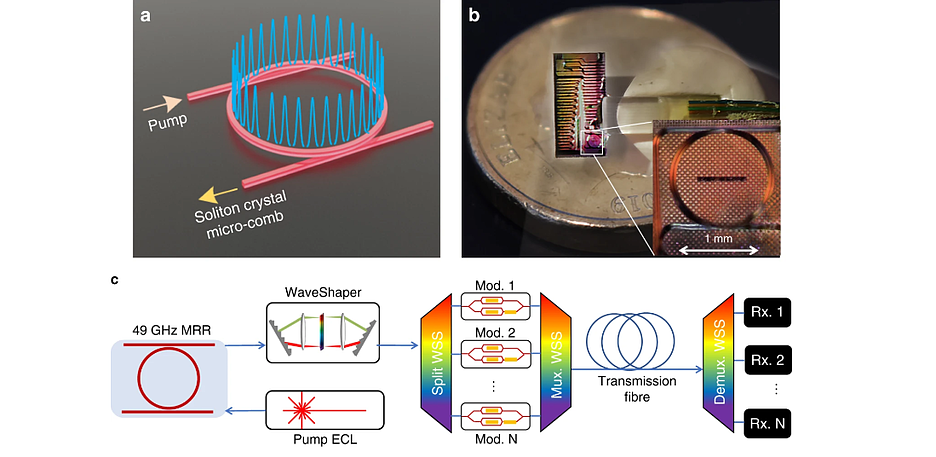The record for the fastest access to the Internet at 44.2 TB/s installed using optical chipatala Solovyov | 30.05.2020

A group of researchers from the Australian University of Monash University and the universities of Swinburne University and RMIT University (Australia) with a single optical chip
were able to achieve a record speed of Internet connection and 44.2 TB/s. At this speed, for example, users can download 1 thousand films in HD-quality for a fraction of a second.
The researchers were able to test the load network using part of the already existing fiber-optic communication infrastructure for Melbourne – 76,6 km of dark optical fibers, laid
between the campus of RMIT in Melbourne and a Monash University campus in Clayton. For optimization of the network, the researchers used a new device known as the microcomb (micro-comb) – an optical device
based on miniature photonic chip, which is significantly smaller and lighter than the existing telecommunications equipment – its dimensions are only about 3×5 mm. In the framework
project microcomb was first tested in the field using existing infrastructure. The microcomb chip consists of hundreds of infrared lasers, each of which can be
used as a separate communication channel. The researchers were able to transmit the maximum amount of data on each channel, simulating peak Network load.
“Using micro-combs for the organization of fiber-optical telecommunications, ultra high-throughput quite real. Our work, in which was set
the world record for the bandwidth of one optical fiber from a single source of chip represents a huge breakthrough and give possibilities to meet a truly
the insatiable global demand for bandwidth”, – said one of the leaders of the study, Professor David moss (David Moss) from Swinburne University.
All the test results were published in the prestigious journal Nature Communications, as well as on the official web site of Swinburne University. At
the forecast of the scientists who led the study, established the speed record of the Internet connection can not only accelerate the development of telecommunications capacity in Australia over the next 25 years
years, but also to distribute new technologies around the world. The latter is able to support high-speed Internet access simultaneously for 1.8 million households in Melbourne and
for billions of users worldwide at peak times.
“The goal of the project is to increase the ability to transfer hundreds of gigabytes per second to tens of terabytes per second without increasing size, weight or cost of the network equipment.
In the long term we hope to create integrated photonic chips that could provide such speed of data transmission over existing fiber-optic lines with
minimal cost,” commented co-author Professor Arnau Mitchell (Arnan Mitchell) from RMIT. – In the initial stages they could be used to provide ultra-high speed
the connection between the Datacenters. However, you can imagine that this technology will become cheap and compact enough for widespread commercial use around the world.”
“An unprecedented number of people using the Internet for remote work, communication, and streaming, has shown us that we must be able to scale the capabilities of our
Internet connections, says the prospects of the project, one of its authors, Dr. bill Corcoran (Bill Corcoran) from Monash University. – Our study demonstrates the ability of the
the existing fiber-optic infrastructure be the basis for a scalable communication networks of the future who will be able to meet all future needs. It’s not just about Netflix,
but the increased use of communication networks for vehicles of the future, for medicine, education, Finance and e-Commerce and much more.”
Journal: Journal IT-News, Subscription to magazines









